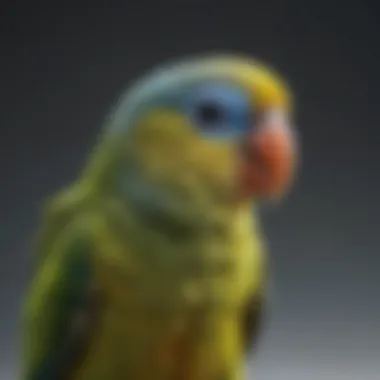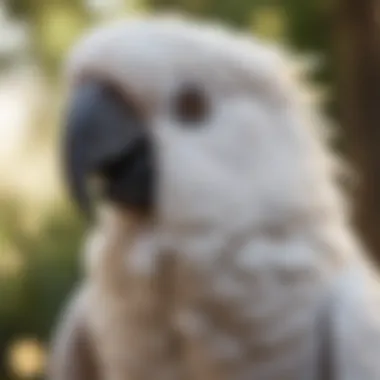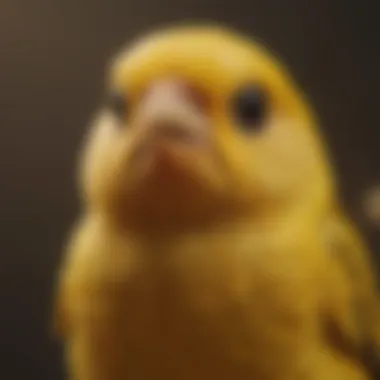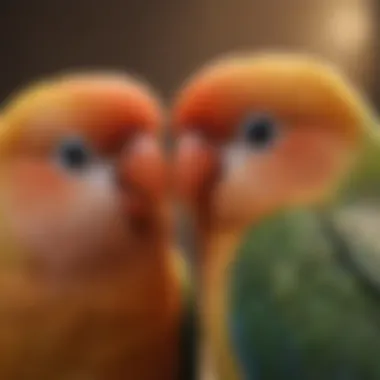Understanding Head Bobbing in Pet Birds Behavior


Intro
Head bobbing in pet birds is a fascinating behavior that can be observed in a variety of species. At first glance, it might appear random or peculiar to those unfamiliar with avian communication. However, understanding this behavior reveals significant insights into a bird's well-being and emotional state.
Birds engage in head bobbing for multiple reasons, ranging from showing excitement to communicating social intention. For pet owners, recognizing the nuances of this behavior can enhance their interactions with their feathered companions. This article seeks to decode the intricate meanings behind head bobbing, consolidating various behavioral theories to equip bird owners with valuable knowledge. Through exploring practical care tips, behavioral insights, nutrition guides, wellness discussions, and enriching activities, one can achieve a holistic understanding of what drives this characteristic action in birds.
Care Tips
The well-being of pet birds greatly affects their health and, by extension, their behavior. Hence, proper care is paramount. Here are essential elements to consider:
Daily Care Routines
Routine feeding and interaction are fundamental to a bird's emotional and physical health. Ensure cuddling or social interaction is regular.
- Feed your bird fresh vegetables, fruits, and high-quality pellets every day.
- Repeat daily basic training or engage in communication to keep them socialized.
Cage Setup and Maintenance
A suitable living environment must include sufficient space.
- Provide a cage large enough to allow for movement.
- Vary perch types and positions to promote comfortable resting.
- Regularly check for hazards in and around the cage.
Hygiene and Cleaning Practices
Good hygiene prevents illness. Always keep the environment clean.
- Change the litter frequently and disinfect surfaces regularly.
- Wash food and water containers regularly to avoid contamination.
Seasonal Care Adjustments
Bird care varies with the seasons. During the changes, alterations might be necessary to accommodate various conditions.
- Increase warmth in winter months.
- Offer cooler spots for summer months to control body temperature.
Behavioral Insights
Understanding bird body language goes hand-in-hand with observing head bobbing behavior. Social creatures require interaction. Knowing these insights is critical for happy birds.
Understanding Bird Body Language
Head movement often indicates various emotional states. Look for other body signals too, like chirping or posture, when interpreting feelings.
Common Behavioral Issues and Solutions
Issues like stress can lead to undesirable behaviors. Identifying triggers is crucial.
- Addressing, fear, boredom, or health issues early on can prevent more severe problems.
- Establish safe environments to reduce anxiety and promote confidence.
Positive Reinforcement Techniques
Positive reinforcement yields a better relationship.
- Use inviting tones during training;
- Offer favorite treats after desirable actions as incentives.
Social Interaction Needs
Birds are inherently social. Hours of solitary existence may afect their moods әрі behavior negatively. Engage daily with them while ensuring they get social exposure, whether mixing them with other pet birds, if suitable.
Nutrition Guides
Mindful nutrition eases many health-related apprehensions. Identifying diet essentials can prove invaluable.
Essential Diet Components
A well-balanced diet includes components vital for body function.
- Include seeds, nuts, chia or sunflower seeds, and wholesome cashews in moderation.
- Fresh fruits and vegetables provide additional vitamins while adding flavor.
Safe and Toxic Foods
Familiarize yourself with avian-safe food practices.
- Bananas, cooked beans, and broccoli are superb treats
- Avoid anything containing caffeine or almonds and avocado, as they are toxic.
Supplements and Treats


Sometimes additional items, like avian vitamins or mineral blocks, may be necessary.
Feeding Strategies for Different Species
Pet birds vary in nutritional needs. Thus, feeding strategies need recalibrating based on species. Canaries differ from cockatoos, so observe specific dietary requirments.
Wellness and Health
Wellness care ensures longevity. Access to routine health examinations grants bird owners advantages. To that end:
Routine Health Checkups
Regular visits to avian veterinarians are crucial in maintaining health. Include them in your bird's life early and often.
Identifying Symptoms of Illness
Birds discreetly show signals of illness. Avian owners understand subtle changes in behavior crucial for response.
- Some aspects needing attention may include lethargy, changes in habits, or neglecting grooming themselves.
Preventative Care and Vaccinations
Preventive measures save lives. Regular vaccinations and treatments can avert serious outbreaks of common avian diseases.
Mental and Emotional Well-being
Stress and loneliness influence mental health; take precautions accordingly.
- Exercise and a balanced interacting/socializing time are significantly rewarding to your concerning pet's welfare.
Enriching Activities
Enrichment installations lead to happy birds. Quality experiential learning tools ensure physical royalties and cognitive well-being.
Toys and Playtime Ideas
Provide an array of safe, interactive toys. Bright toys and mirrors often intrigue curious birds. Offer mixed options daily for stimulating their needs.
Training and Tricks
Simple tricks keep their minds engaged and strengthen bonds. Reinforce ownership through play and training.
Outdoor Activities and Interaction
Freedom outdoors brings joy responsively. Proper security protocols and free, open space enhance appreciation for exploration.
DIY Projects for Mental Stimulation
Creating enriching experiences independent of complex machinery can elevate engagement.
A simple cardboard puzzle or raw paper towel can engage birds deeply, preventing boredom!
In post-analysis, understanding head bobbing encompasses various aspects of avian behavior and communication. Fostering healthy, enriched environments and routines and prioritizing well-being leads to happy interactions and eventual nurturing of a mutual bond.
Prelude to Head Bobbing in Birds
Understanding head bobbing behavior in birds is crucial for any pet bird owner. This act can vary significantly from one species to another and offers essential insights into their communication, emotional states, and social interactions. Knowledge about head bobbing not only advances engagement with these charming creatures but also fosters a deeper understanding of their needs and well-being.
Defining Head Bobbing Behavior
Head bobbing is a distinctive, repetitive movement in which a bird raises and lowers its head rhythmically. This phenomenon is often seen in several bird species, and the triggers for such behaviors are multifaceted, ranging from excitement to stress. In a basic sense, head bobbing serves as a body language sign in birds, conveying different emotions or intentions. Pet bird owners should pay close attention to these movements to discern what their feathered friends are trying to express. It can indicate joy, curiosity, or even unrest, based on the context in which it occurs. Understanding the meaning behind head bobbing helps enrich the bonding experience between birds and their owners.
Common Bird Species That Exhibit This Behavior
Certain bird species are notably recognizable for exhibiting head bobbing as a standard behavior. Understanding which birds partake in this action enhances appreciation for their distinctive characteristics:
- Budgerigars: Also known as budgies, they are particularly vocal and show head bobbing during playful or social interactions.
- Cockatiels: These small parrots display this behavior often when feeling happy or excited, particularly during interactions.
- Lovebirds: They exhibit head bobbing, especially during courtship activities or when engaging with their partners.
- Amazon Parrots: These birds signify contentment through rhythmic head movements while interacting with human companions.
Recognizing which species are more prone to head bobbing enhances an owner's understanding of behavioral indicators unique to their pets. Monitoring these movements leads to better communication flow, ensuring both bird and owner enjoy their time together.
The Purpose of Head Bobbing
The phenomenon of head bobbing in birds serves multiple purposes that are deeply intertwined with their behavior and social interactions. Understanding these purposes provides pet bird owners with insights into their birds' needs and emotional states. Recognizing this behavior can enhance the owner-bird relationship, aligning care with the intrinsic motivations of the avian companion.
Communication and Interaction
Head bobbing often serves as a form of communication among birds. This behavior can signal various emotional states, from excitement to curiosity. For example, when a cockatoo bobs its head, it may express enthusiasm, inviting interaction. Conversely, more subdued head movements can indicate a bird that is contemplative or even cautious.


Pet bird owners must observe their birds closely. Understanding the context of head bobbing is crucial. When birds head bop during socialization, it is a time for bonding. Interactive behaviors that involve head movements often strengthen the relationship between the bird and its owner. Active engagement can improve emotional wellbeing in birds and help to reduce stress.
Courtship Displays in Avian Species
Courtship displays are another critical reason for head bobbing. In many species, males will bob their heads to attract females during mating rituals. For instance, budgerigars and cockatiels often exhibit pronounced head bobbing during their display routines. This not only showcases their agility and vigor but also indicates their suitability as a mate.
Watching for these behaviors in your pet birds can increase your understanding of avian romance. Providing an environment that allows for such displays can promote a more natural, engaged experience. Partnering with your bird during this phase can encourage a deeper bond and stimulate your avian friend's natural instincts.
Playfulness and Engagement
In addition to communication and courtship, head bobbing can also signify playfulness. Birds are naturally curious and often engage in playful behavior to explore their environments. A pet bird may bob its head when playing with a favorite toy, indicating their excitement and enjoyment.
This playful head bobbing reflects how comfortable and happy a bird feels in its surroundings. For owners, understanding this can inspire the creation of a more enriching environment. Interactive playtime not only fosters mental stimulation but also encourages this endearing behavior.
Investing time into observing and interpreting head bobbing can significantly enhance both the owner's knowledge and the bird's quality of life, deepening the mutual connection.
Observing wanting head movements allows owners understand their birds needs for interaction, play, and emotional expression.
By focusing on these purposes of head bobbing, pet owners can tailor their care more effectively, ensuring that their birds thrive not only physically but also emotionally.
Head Bobbing as a Sign of Comfort
Birds often display various behaviors to communicate their emotional state and environment comfort. Understanding head bobbing as a sign of comfort is essential for bird owners. This behavior typically indicates contentment and security. Observing your pet bird can give you insights into its mood and overall well-being. When a bird feels safe and relaxed, it is more likely to engage in head bobbing, signifying a positive state of mind.
Positive Reinforcement in Training
Using positive reinforcement strategies can enhance your bird's head bobbing behavior. When a bird performs the head bobbing, it can be further encouraged with treats or praise. This action is rewarded, making it more likely that the bird will repeat this behavior in the future. This can also include simple verbal affirmations or physical indicators of approval. Additionally, associating head bobbing with enjoyable experiences reinforces a bird's original comfort, creating a happier pet.
Consider the following positive reinforcement tips:
- Offer flavorful treats when the bird bobs its head in joy.
- Use a gentle tone of voice to praise your bird.
- Engage in interactive play so it connects the head bobbing to activity.
These methods can help strengthen the existing comfort and enhance your relationship with your pet bird.
Environmental Influences on Behavior
The environment plays a significant role in the display of head bobbing. Factors such as the layout of the cage, noise levels, and presence of other animals can either promote or inhibit this behavior. A stimulating environment encourages head bobbing, as the bird feels secure and engaged. Natural light, spacious areas, and varied climbing structures contribute positively. Conversely, a cramped or noisy habitat may lead to stress and anxiety, reducing the joy expressed through head bobbing.
To ensure a bird-friendly environment:
- Arrange toys and perches at different heights to create space versatility.
- Keep the living area free of abrupt noises or unsettling stimuli.
- Allow enough exposure to natural light.
Creating the right ambiance facilitates comfort. A comfortable setting nurtures head bobbing as an expression of safety and happiness.
Psychological Factors Influencing Head Bobbing
Understanding the psychological factors influencing head bobbing is crucial for pet bird owners. These factors can reveal a lot about their birds' emotional states and well-being. Awareness of stress, anxiety, and boredom among pet birds greatly contributes to better care and enrichment strategies.
Stress and Anxiety Responses
Birds may bob their heads as a response to stress or anxiety. This behavior can serve as a coping mechanism for them in uncomfortable situations. When a bird feels threatened by loud noises, sudden movements, or new environments, head bobbing can be a way to deal with these feelings.
Identifying stressful triggers is important for bird owners. Here are a few common stressors:
- Loud sounds, such as fireworks or thunder
- Handling by unfamiliar people
- Encounters with predators, such as cats
Signs of stress in birds might include:
- Excessive head bobbing
- Feather fluffing
- Vocal changes
Addressing these realities often necessitates a calming and consistent environment. Providing safe Spaces, along with comfort items like perches and toys, can help reduce stress for your feathered friends. Owners must observe their pets for periods of change in behavior, adjusting the surroundings as needed to promote wellness.
Boredom and Its Impact
Boredom can greatly affect a bird's behavior. In pet birds, a lack of stimulation can lead to head bobbing as a sign of unrest. Such behavior may denote that birds are looking for an avenue to engage and interact, even if the action itself does not directly serve that purpose.
Across various species, boredom can manifest in several ways:
- Destructive behavior, like chewing on cage bars
- Vocalization increases, which may indicate a desire for interaction
- Frequent display of head bobbing when alone or in isolation
To combat boredom, it is crucial for bird owners to enrich their birds' environments. This includes providing different toys, varied perches, and opportunities for social interaction. Classic enrichment ideas include changing toys regularly, playing soft music, and allowing supervised time outside the cage.
Understanding the psychological factors influencing your bird can result in a happy and healthy companionship.
Differentiating Normal and Abnormal Head Bobbing
Understanding the difference between normal and abnormal head bobbing behaviors in pet birds is crucial for caregivers. This knowledge aids in identifying behavioral patterns that are indicators of the overall health and wellness of birds. When caregivers recognize these behaviors early, they can make necessary adjustments to their pets' environments, routines, or seek veterinary advice when required.


Factors Indicating Healthy Behavior
Normal head bobbing often represents a healthy communication style among birds. Some specific signs indicate this positive behavior:
- Regularity: Typical head bobbing occurs naturally at varying times.
- Enthusiasm: Engaging songs or games may lead to more energetic bobbing, indicating that the bird is feeling happy and stimulated.
- Interactions: Birds usually bob their heads in response to the presence of their owners, children, or other pet birds, showing comfort and social behavior.
- Playfulness: Partaking in habits like head bobbing while playing demonstrates the bird's engagement and contentment.
Birds that exhibit these typical signs are generally signaling their happiness, comfort, or excitement in various scenarios.
Signs of Medical or Behavioral Issues
On the other hand, there are specific markers indicating that head bobbing may not be typical. Potential signs of medical or behavioral issues include:
- Persistent and Excessive Bobbing: If head bobbing becomes steady or involuntary, it may signal discomfort or distress.
- Accompanied by Other Symptoms: Abnormal head bobbing paired with other factors, such as fluffed feathers, lethargy, or excessive vocalization, may indicate health problems.
- Signs of Stress: Observing a change in a bird's bobbing rhythm due to environmental changes can indicate induced anxiety. Environment plays a key role in avian behaviors.
- Out of Context: Bobbing that occurs during unusual times, especially when a bird appears unwell otherwise, should raise suspicions.
Monitoring these signs can help bird owners discern when a trip to the veterinarian or environmental adjustments might be necessary to better support their pet's health.
Proper observation contributes to early intervention, sustaining overall bird well-being.
Cultural Significance of Head Bobbing
The cultural implications of head bobbing in birds extend beyond mere observations. This behavior can signify various messages in both wild and domestic environments. For pet owners, understanding its cultural significance can truly enhance the bird-keeping experience. They have the potential to interpret and nurture their birds according to their terms and expectations, ensuring a fulfilling bond between the owner and their avian companions.
Head Bobbing in Wild Birds
In wild birds, head bobbing often serves important ritualistic roles. Biologists observe head bobbing as a method of communication between individuals, a signal for everything from hostility to courtship. For instance, in species like the Anna's hummingbird, such a behavior can attract mates not just during breeding but can help establish a social hierarchy.
Birds also use head bobbing while foraging. This movement can imitate the visual cues of potential food in stagnant environments. It assists in situational awareness against predators. Pet owners might see this behavior mirrored in their birds.
Different bird species display unique head bobbing behaviors. Parrots, for example, often show head bobbing during play, suggesting excitement and energy. Understanding these parallels within both wild and domestic species cultivates a more profound appreciation of their well-being.
Implications for Bird Keeping Practices
For bird owners, putting head bobbing into context can greatly influence their observational skills. Being aware of head bobbing contexts allows owners to cater better to the birds' needs and enhances overall care. Key considerations include:
- Monitoring Behavior: Owners should consistently observe their birds. Changes in head bobbing might highlight stress or discomfort unconsciously reacted to in different environments. This consistency can reveal insights and help in creating preventive care plans.
- Creating Enriching Environments: Birds thrive in stimulating settings. Providing appropriate toys or peer interactions can catalyze positive head bobbing, which reflects comfort and balance in their environment.
- Positive Reinforcement Training: Cultivating desired head-bobbing behavior during interactions encourages a closer relationship. Positive engagement can reward calm acceptance in various situations.
Critically analyzing head bobbing can allow pet owners to foster habitats and rituals that honor birds' natural inclinations, adapting care strategies for health and connection.
Recognizing and understanding head bobbing elevates bird keeping from basic to expert, ensuring a fulfilling and engaging environment for every avian companion.
Practical Tips for Bird Owners
Monitoring Behavior Consistently
Monitoring a bird’s behavior involves paying careful attention to daily activities. Birds often communicate their feelings through actions that can sometimes be subtle. Observing head bobbing can help distinguish these signs. By noting when and how often your bird exhibits this behavior, you can identify patterns.
Key Points for Consistent Monitoring:
- Keep notes on daily behaviors.
- Observe during different times of day.
- et a routine for observing your bird when it's active.
This kind of attentiveness can assist in recognizing when a bird might be experiencing stress or discomfort. Changes in head bobbing frequency could signal various emotional states, ranging from joy to anxiety. By acknowledging these changes promptly, you have a better chance of addressing any underlying issues before they become problematic.
Creating Enriching Environments
Creating rewarding environments for pet birds involves more than just providing the basics like food and water. An enriched environment facilitates natural behaviors and keeps mental stimulation high. Such aspects are key in keeping your bird feeling safe and content.
Elements of an Enriching Environment:
- Variety of Toys: Rotate toys regularly to prevent boredom.
- Social Interaction: Spend quality time interacting with your bird.
- Safe Exploration: Create safe areas for your bird to investigate.
Such mixed aspects assist in fostering positive behaviors,like head bobbing, which often reflect happiness or engagement with their surroundings. Keeping an eye on how changes in environment influence behavior could provide insight into your pet's likes and dislikes. Experimenting with various enrichment materials leads towards well-adjusted, cheerful birds.
Bird owners should remember that a fulfilling environment leads to happier birds, ultimately enhancing the bond between the pet and its owner.
In summary, consistent observation and creating enriching surroundings represent critical areas of care. By actively focusing on understanding head bobbing within the context of these practices, pet owners can cultivate an atmosphere that significantly benefits their bird's welfare.
End
Understanding head bobbing in pet birds goes beyond mere observation. This bubbling phenomenon is a window into the creature’s emotional state, social interactions, and overall behavior. By examining key aspects of head bobbing, we can deepen our connection with our avian companions while ensuring their happiness and well-being.
Recap of Key Points
- Behavioral Communication: Head bobbing serves various functions in avian interaction, reflecting excitement, curiosity, or even the desire to mate.
- Indicator of Comfort: Healthy birds often display head bobbing as a sign of enthusiasm or contentment, fundamentally altering how we perceive their behavior.
- Environmental Factors: The setting that a bird is in plays a significant role in its actions. An enriched environment can promote joyful head bobbing, while dull surroundings might breed stress and anxiety.
- Social Dynamics: Changes in head bobbing behaviors can indicate various social situations among avian species, affecting how they engage with both humans and other birds.
- Differentiation of Behavior: Recognizing differences between normal and abnormal head bobbing can ensure timely intervention if underlying health concerns arise.
Encouragement for Ongoing Learning
In the realm of pet bird keeping, understanding behavioral mechanics like head bobbing is essentially a journey. Encouraging continuous education empowers bird owners to provide better quality lives for their pets. Various resources can further enhance knowledge:
- Online Forums: Engage with bird owner communities on platforms like Reddit or Facebook.
- Literature: Reading updated articles and journals on avian behavior can provide insights into the latest findings in the field.
- Workshops and Webinars: Participating in live discussions led by avian experts can offer more hands-on learning opportunities.
Embrace the role of an informed guardian. The joy derived from knowing and understanding your pet’s actions translates to a satisfying experience for both parties. It fosters a deeper emotional connection and a healthier environment.
Knowledge aids in creating more enriching experiences for pet birds. Continuous learning leads to better care and awareness regarding their behaviors.















